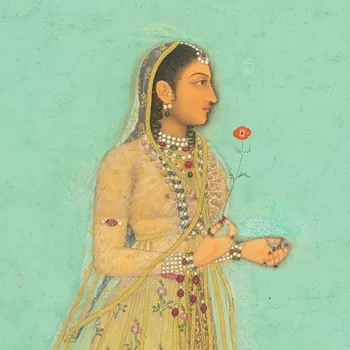Gulistan-i Sadi گلستان سعدی (The Rose Garden of Sadi) 1584
35.8 x 23.8 cm (book measurement (conservation)) | RCIN 1005022
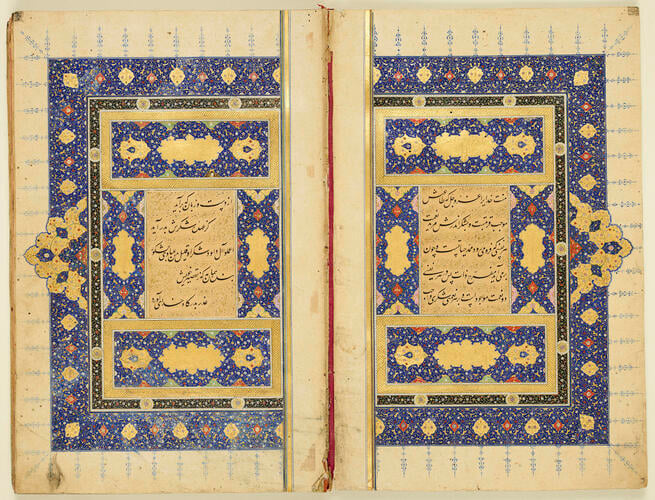
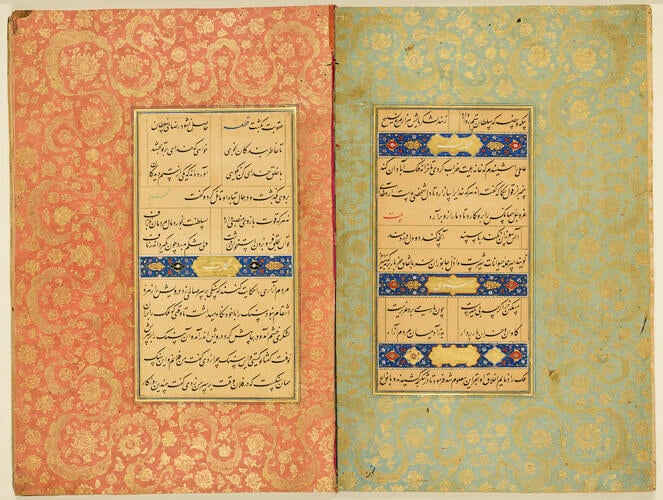
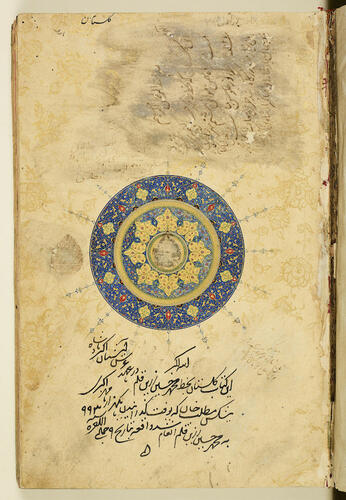

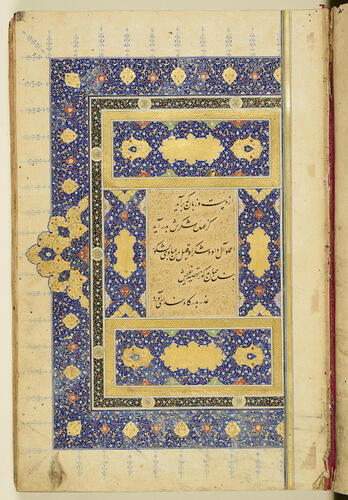

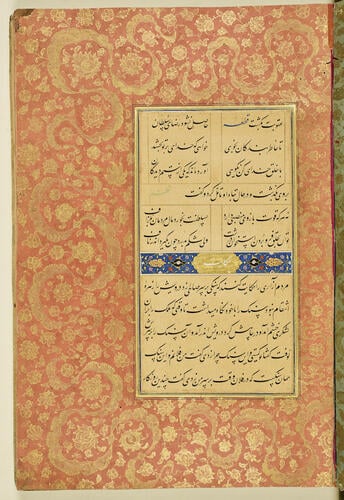
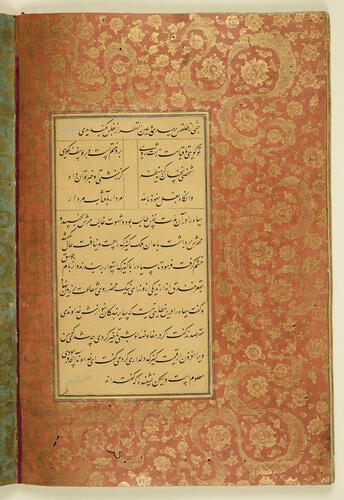

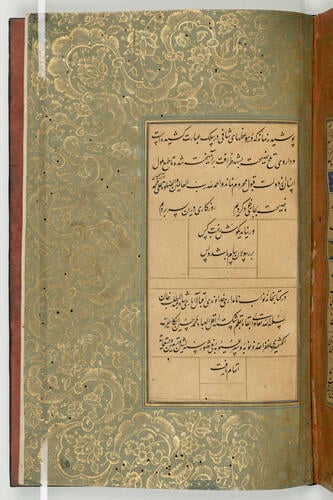


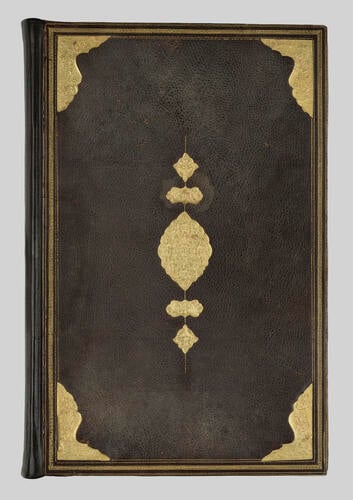

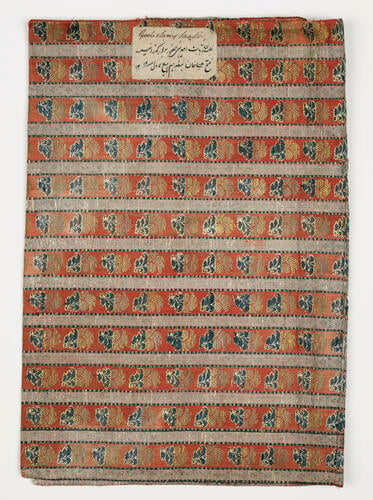

-
A Mughal volume of the Persian classic written in 1584 in Agra by the calligrapher Muhammad Husayn Kashmiri.
The Gulistan is a book of Persian prose written in 1258 by Sheikh Sadi Shirazi, a writer widely recognized as one of the greatest masters of the classical Persian literary tradition. Gulistan means ‘the rose garden’ and the text is divided into eight chapters called babs (‘gates’) corresponding to the eight gates to the garden of paradise. It is a moralistic and anecdotal work mostly written in hikayats (short prose vignettes) combined with verse. These are light and humorous in tone, particularly in comparison to his earlier work, the Bustan (‘fragrant garden’, see RCIN 10015). The poet writes in the Gulistan’s epilogue that his aim was to deliver advice in palatable form. It was used as textbook for education for centuries across the Persian-speaking world and was the primary text of Persian language instruction of East India Company officers at Fort William College in Calcutta (est. 1801) and at Haileybury College in England (est. 1806).
This manuscript volume of the Gulistan is the work of Muhammad Husayn Kashmiri (d. 1611), a Mughal calligrapher whose celebrated style of nastaliq script earned him the title zarrin qalam (‘Golden Pen’) and the admiration of generations of Mughal emperors. According to the colophon, he completed the text in the library of Abd al-Muttalib Khan, a nobleman and personal attendant of Emperor Akbar (r. 1556-1605), in Agra in 1584. The large volume opens with a shamsah ('little sun') and an illuminated double-page frontispiece. It is decorated throughout with richly coloured borders with floral and arabesque designs painted in gold.
Several inscriptions and seals attest to the manuscript’s long history in the Mughal imperial library. Notes on the reverse of the manuscript’s first folio include those in the hands of Emperors Jahangir and Shah Jahan, and the imperial seals of Emperors Shah Jahan and Alamgir. The seal of Abd al-Ahad Khan, a close advisor to Emperor Shah Alam II (r. 1728-1806), dated 1169AH (AD 1756) is impressed on every folio. This seal is often cropped, indicating that the manuscript’s pages were trimmed before being bound into their present late eighteenth century covers.
By the late 18th century, the manuscript was in the collection of the Awadhi royal library at Lucknow. In 1798, Saadat Ali Khan, Nawab of Awadh, presented the Gulistan with five other manuscripts from the royal library (including a volume of Sadi’s Bustan) to Lord Teignmouth, Governor-General of India (1792-99), intended as gifts for George III. In a memo written for the king, Teigmouth described the volumes and where George III would find a translation of the texts: ‘Goolistan or Garden of Roses by Sheikh Saadi of Shiraz. This manuscript is written by Mahomed Hussein surnamed Golden Pen for Abdul Mutleb Khan an officer in the Court of Akbar. A note in the first page mentions that the writer was rewarded 1000 Gold Mohrs, & nothing can exceed the beauty or perfection of the writing… The Goolistan is in Prose, with a mixture of verse, & has been translated into Latin by Gentius.’
The manuscript arrived in London in 1799 in its current binding of black morocco with gilt-stamped medallions and border lines covered with a silk wrapper of Benares brocade.Provenance
Presented to King George III by Lord Teignmouth, Governor-General of India, c. 1799.
-
Creator(s)
(author)(calligrapher)(nationality)(nationality)Acquirer(s)
-
Measurements
35.8 x 23.8 cm (book measurement (conservation))
Category
Object type(s)





